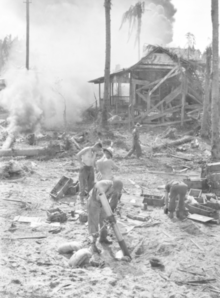2/2nd Anti-Tank Regiment (Australia)
| 2/2nd Anti-Tank Regiment | |
|---|---|
.png) Balikpapan, Borneo, 4 July 1945 | |
| Active | 1940–1946 |
| Country |
|
| Branch | Australian Army |
| Type | Royal Australian Artillery |
| Role | Tank Attack |
| Part of | Second Australian Imperial Force |
| Motto(s) |
Latin: Ubique consensu stabiles Australia ("Everywhere unanimously steady Australia")[1] |
| Engagements | |
| Commanders | |
| Notable commanders | Rickard, Arthur Lancelot (1940–1941) |
| Insignia | |
| Unit Colour Patch |
 |
The 2/2nd Anti-Tank Regiment was an Australian Army anti-tank artillery regiment that was raised for service during the Second World War. Formed in 1940 in Brisbane, Queensland, the regiment was assigned to the 7th Division and was deployed to North Africa in 1940, and subsequently saw action there and in the Middle East. It was later brought back to Australia and later fought against the Japanese in New Guinea and on Borneo before being disbanded in 1946.
History
Formation
The 2/2nd Anti-Tank Regiment was formed near Redbank, Brisbane in Queensland in 1940.[2] It consisted of three batteries: 5th, 6th, 7th, 8th Anti-Tank Batteries. The regiment would see service in the North African campaign, Northern Palestine, Egypt, Syria and then later Darwin and Borneo. The men of the 2/2nd were of all walks of life, from both the city and the country and their ages ranged from 18–40 years of age. The regiment became a part of the artillery force of the 7th Division, leaving Australia for the Middle East in 1940.[2][3]
Action
The regiment trained in Palestine, then moved to Egypt and the Western Desert. There they took up defence of Mersa Matruh before moving to the north of Palestine to take part in the invasion of Syria. The regiment returned to Australia, serving within Australia (Darwin, Northern Territory), New Guinea and Borneo.[2]
The regiment was sent to Egypt with the 7th Australian Infantry Division in October 1940 and arrived on 14 December 1940. On arrival the division moved to Palestine, but was sent to Egypt in March 1941 to garrison Mersa Matruh. 'C' Troop of the regiment served at Salum in April 1941, while the 5th Battery came under command of the 7th Support Group in Salum from 12–13 April 1941. It served in the Halfaya battles during May 1941. The 6th Battery was detached to 22nd Guards Brigade and the 5th Battery to the 7th Support Group during Operation Brevity in May 1941. In mid-May 1941, the regiment returned with the 7th Division to North Palestine and served with them in the Syrian campaign from 8 June to 12 July 1941 with the 5th Battery detached to British 6th Infantry Division. The 2/2nd remained in Syria as an occupational force until June.
The regiment moved to Batchelor in Northern Territory in June 1944 to replace 103rd Anti-Tank Regiment under HQ RAA, NTF. The 2/2nd then left in September 1944 for Atherton, Queensland, there it was trained with the 7th Division. The unit was then moved to New Guinea and continued to follow the movement of the war (detachments spread among pacific campaigns). It landed with 7th Division in Balikipan, Borneo on 1 July 1945.[4][5]
Two members of the regiment, Staff Sergeant D. L. W. Morrison and Major G. G. Schneider, are recorded by the Australian War Memorial to have been captured in the Malayan Campaign and then made prisoners of war.[6] Twenty men are recorded to have been killed in service of the 2/2nd; of these, two were killed on Australian soil.[7]
Battle of Brisbane
The 2/2nd's involvement in Battle of Brisbane came about through the actions and death of one of its members, Gunner Edward Webster (Webbie). On 26 November 1942, Brisbane was shaken by riots, protesting and violence over disputes between American and Australian servicemen, Webster was the only person during the riots to have been killed. He was killed by Private Norbert Grant an MP of the United States military. Grant killed Webster with a shotgun which was fired three times, wounding many other Australian servicemen at the same time during a frantic struggle to disarm Grant. Grant was court-martialed by the US military for manslaughter, he was later acquitted as what was later explained to have been self defence.[8][9]
Disbandment

The 2/2nd was disbanded in Queensland in 1946 with the 7th Division. Its members held annual meetings in Brisbane, Queensland, until 2004, when its remaining numbers were too low to support such a practise.[10] Military decorations awarded to members of the 2/2nd Anti-Tank include: 2 Distinguished Service Orders, 2 Military Crosses, 2 Military Medals and 5 Mentioned in despatches.[5] 19 men of the 2/2nd feature on the Roll of Honour at the Australian War Memorial. Foreign fields mentioned on the 2/2nd's ANZAC day banner are: 'Syria', 'Palestine', 'Egypt', 'New Guinea', 'Morotai', 'Balikpapan' and 'Libya'.[1]
Gallery
 75mm Pack Howitzer demonstration by the 2/2nd.
75mm Pack Howitzer demonstration by the 2/2nd. Elements of the 2/2nd on occupational duties in Tripoli 1941.
Elements of the 2/2nd on occupational duties in Tripoli 1941. Members of the 2/2nd Tank Attack Regiment removing the breech block during a demonstration of stripping a 75mm Pack Howitzer.
Members of the 2/2nd Tank Attack Regiment removing the breech block during a demonstration of stripping a 75mm Pack Howitzer. Tank Rock, QLD. 1944-11-27. A 2/2nd Tank Attack Regiment gun crew load 6-pounder gun during practice at the artillery range.
Tank Rock, QLD. 1944-11-27. A 2/2nd Tank Attack Regiment gun crew load 6-pounder gun during practice at the artillery range.
References
- 1 2 "Marching banner: 2/2 Australian Anti-Tank Regiment Association". www.awm.gov.au. Retrieved 2018-01-15.
- 1 2 3 "2/2 Australian Anti Tank Regiment Association @ SNAC". snaccooperative.org. Retrieved 2018-01-14.
- ↑ "2nd/2nd Anti Tank Regiment". rslvirtualwarmemorial.org.au. Retrieved 2018-01-15.
- ↑ A Pictorial Record of The Way We Were 1940 – 1945 (2/2nd Australian Anti Tank Regiment). Australia: Australian Gov. 1997. pp. 5–64. ISBN 9780541294687.
- 1 2 "2/2nd Anti-Tank Regiment". www.awm.gov.au. Retrieved 2018-01-15.
- ↑ "G G Schneider". www.awm.gov.au. Retrieved 2018-01-15.
- ↑ "2/2nd Tank Attack Regiment RAA Plaque". www.qldwarmemorials.com.au. Department of Environment and Heritage. Retrieved 2018-01-15.
- ↑ "Wartime 'Battle of Brisbane' remembered". ABC News. 2009-11-26. Retrieved 2018-01-24.
- ↑ "The Battle of Brisbane - 26 & 27 November 1942". www.ozatwar.com. Retrieved 2018-01-24.
- ↑ "2/2 Australian Anti Tank Regiment Association @ SNAC". snaccooperative.org. Retrieved 2018-01-15.
Further reading
- Horner, David (1995). The Gunners. A History of Australian Artillery. Sydney, New South Wales: Allen & Unwin. ISBN 1863739173.
- Johnston, Mark (2005). The Silent 7th: An Illustrated History of the 7th Australian Division 1940–46. Crows Nest, New South Wales: Allen & Unwin. ISBN 1-74114-191-5.